Manta Ray Night Snorkel Kona: Ultimate Guide & Tips
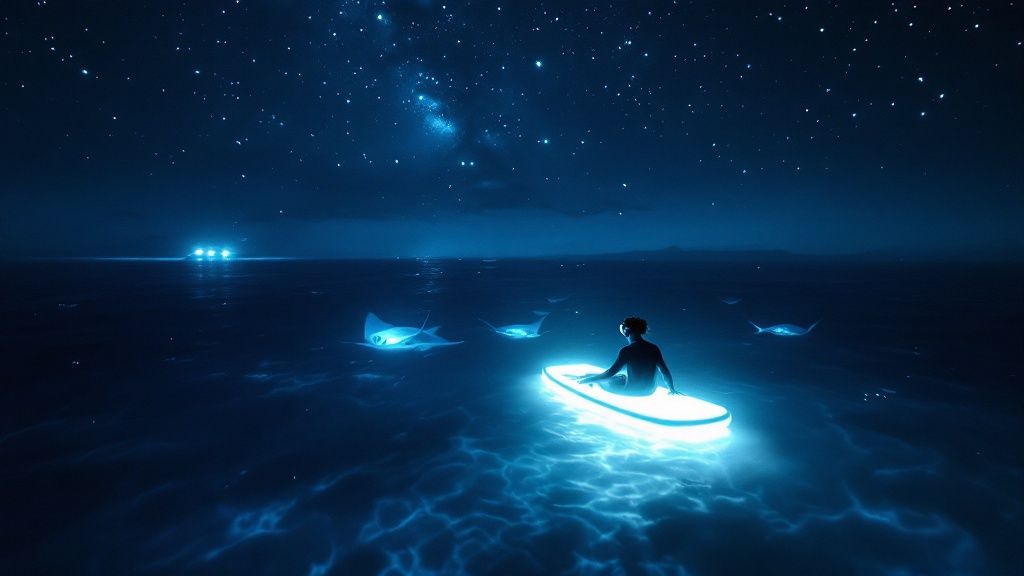
Picture this: you're floating in the calm, dark waters off the Kona coast. Suddenly, a giant, graceful shadow emerges from the deep, gliding just inches below you. Its white belly glows in the underwater lights. This isn't a scene from a documentary—it's the world-famous manta ray night snorkel in Kona, and it's an experience you have to see to believe.
This guide is your complete walkthrough to making this bucket-list adventure a reality.
Experience Kona's Famous Manta Ray Night Snorkel
The Kona coast of the Big Island offers one of the most reliable and jaw-dropping wildlife encounters on the entire planet. While many marine tours are a game of chance, the Kona manta ray night snorkel boasts an incredible success rate, often topping 90%. That consistency turns a simple vacation activity into a near-guaranteed magical memory.
We at Kona Snorkel Trips have built our reputation as the top-rated and most-reviewed snorkel company in Hawaii by focusing on safe, memorable, and educational adventures. But don't just take our word for it—see what fellow travelers have to say.
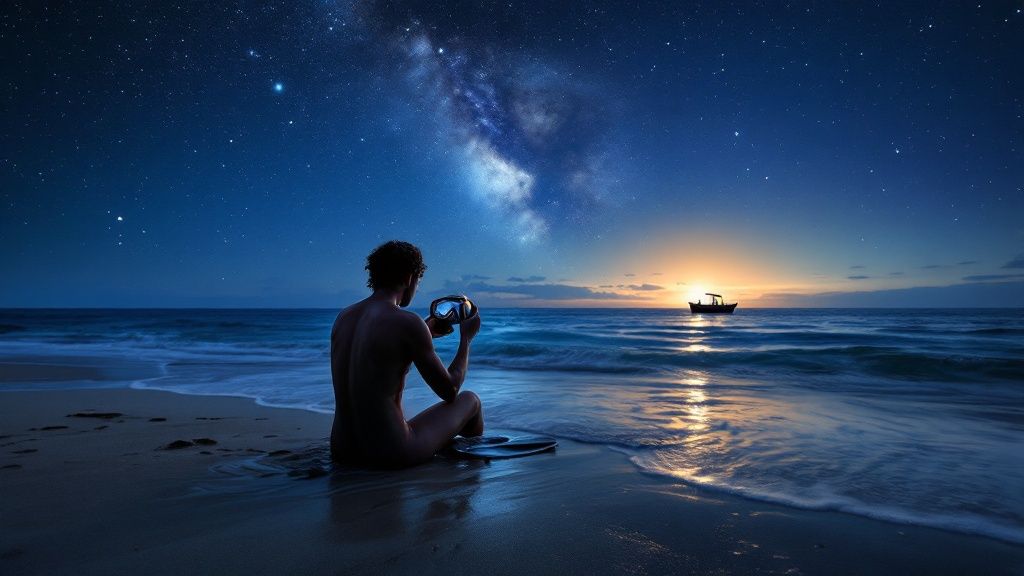
This amazing spectacle works because the manta rays here are essentially locals. They don't migrate far, returning to the same feeding spots night after night. They're drawn in by the massive concentrations of plankton that gather around the bright lights our boats shine into the water. The result is an underwater ballet, with these gentle giants performing graceful barrel rolls as they feed.
Why This Adventure is a Must-Do
Taking part in a manta ray night snorkel is so much more than just another tour; it’s a profound connection with nature. These magnificent creatures, with wingspans that can stretch up to 18 feet, are completely harmless filter feeders. They have no teeth, no stingers, and no barbs, which makes the encounter perfectly safe and serene.
Here’s a quick rundown of what your adventure will look like:
- A quick, scenic boat ride out to one of the designated manta viewing sites.
- A comprehensive safety briefing from your expert guide.
- Getting into the water and holding onto a custom-built, floating light board.
- Watching in absolute awe as manta rays swoop and glide below, feeding on the plankton.
The whole setup is designed to be accessible, even if you're a beginner or not a particularly strong swimmer. The wetsuit keeps you warm and buoyant, and the light board gives you something stable to hold onto. All you have to do is float and enjoy the show. If you're exploring different options, Manta Ray Night Snorkel Hawaii is an exceptional alternative when looking for a Manta Ray night snorkel tour.
The feeling of a massive, gentle creature gliding silently just beneath you is almost impossible to describe. It’s a mix of awe, wonder, and a deep respect for the ocean's inhabitants. Trust me, this is the memory you'll be talking about for years to come.
Booking with a reputable operator like Kona Snorkel Trips ensures you're part of a tour that puts the manta rays' well-being first and follows sustainable tourism practices. Are you ready to see this natural wonder for yourself?
Why Kona Is The Best Place to See Manta Rays
The Kona coast of the Big Island isn't just another pretty spot in Hawaii; it's hands-down the best place in the world for a manta ray night snorkel Kona experience. I've been lucky enough to see a lot of incredible marine life, but what happens here is something special. It’s a perfect mix of biology, geography, and a bit of human ingenuity that creates a reliable, almost magical show every single night.
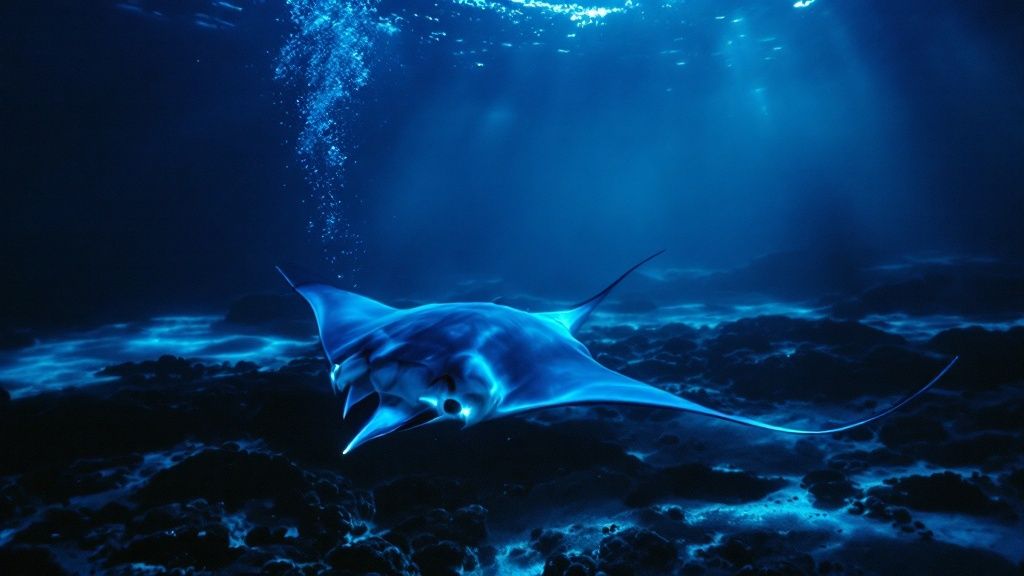
Unlike a lot of wildlife encounters that hinge on migratory patterns and a whole lot of luck, Kona's manta rays are here to stay. They’re reef mantas (Mobula alfredi), a species that tends to stick close to home. This means you can have a world-class encounter with them any month of the year. No seasonal guesswork needed.
The real secret sauce, though, is the unique relationship between light, plankton, and the mantas. The Kona coast has a healthy population of zooplankton, which is the main course on a manta ray’s menu. Years ago, people figured out that shining bright lights on the water attracts these tiny organisms by the thousands, basically creating a "plankton buffet" that the mantas just can't resist.
The Science of the Manta Dance
Tour operators out here have turned this natural behavior into an art form. On a night snorkel, powerful (but eco-friendly) lights are placed in the water. This light draws in a dense cloud of plankton, which in turn brings the mantas right to us.
This simple setup gives you a front-row seat to one of nature's most graceful performances. You'll see the mantas doing these elegant barrel rolls and somersaults, gliding effortlessly through the light beams with their huge mouths wide open. It’s a stunning underwater ballet that happens like clockwork.
This unique, light-attraction method is what makes the Kona experience so dependable. It’s not about finding the mantas; it’s about creating the perfect dining conditions and letting them come to you.
The success rates here are unbelievable, often hitting 85% to over 95% depending on the night and the location. We have a thriving local population of over 450 manta rays, with more than 120 individuals being cataloged by marine biologists and tour guides each year. You can dive deeper into the science and success rates on Kona Honu Divers' blog.
Ideal Conditions and Unique Viewing Sites
Beyond the reliable food source, Kona's geography is perfect for this. We're on the leeward side of the Big Island, which means we're sheltered from the strong trade winds. The result? Consistently calm and clear water, which is exactly what you want for a nighttime swim.
Over the years, a few spots have become famous for these encounters:
- Manta Village (Kaukalaelae Point): This is one of the original and most reliable sites, located just south of Kailua-Kona.
- Manta Heaven (Garden Eel Cove): Found north of the airport, this spot can sometimes host an absolutely massive number of mantas at once.
Both locations are in relatively shallow water, which is perfect for snorkelers. You can just float on the surface and watch the show happen just a few feet below you. It makes the whole experience accessible even for beginners and families. Timing wildlife trips is always smart, whether you're here or checking out marine wildlife seasonality on the other side of the globe.
It's this combination—a resident manta population, a proven attraction method, and perfect ocean conditions—that truly makes Kona the ultimate destination for this adventure. While you're planning your trip, don't forget to check out our full guide to the best snorkeling in Kona for more amazing underwater experiences.
How To Choose Your Manta Ray Snorkel Tour
Picking the right manta ray night snorkel in Kona can feel like a huge decision. With so many great operators on the Big Island, how do you even start? The tour you choose really does shape your entire experience, so it pays to take a minute to figure out what you're looking for. The goal is to find a trip that lines up with your comfort level, budget, and sense of adventure.
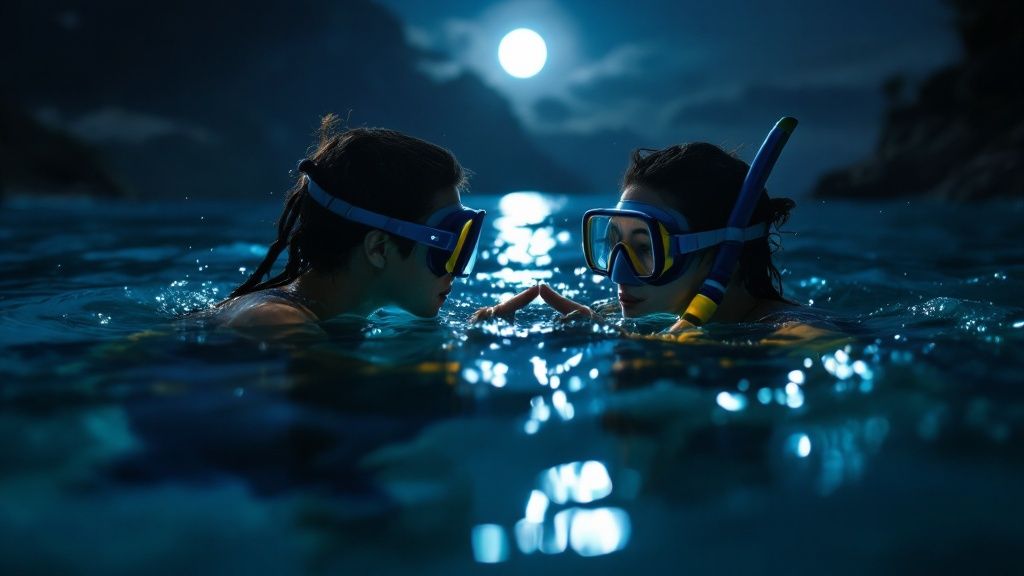
Honestly, your first big choice usually boils down to the size of the boat. Are you the type who prefers a smaller, more personal trip, or would you rather have the stability and creature comforts of a larger vessel? There’s no single right answer here—it’s all about what makes you feel comfortable and excited for the adventure ahead.
If you want to get a lay of the land, checking out a curated list can be a great starting point. This rundown of Kona's Top 10 Manta Ray Night Snorkel Tours is a solid resource for seeing who the reputable local companies are.
Small Boats vs. Large Vessels
So, what's the real difference between a small boat and a big one? A small group tour, often on a zippy zodiac-style boat, feels a lot more personal and adventurous. With fewer people on board, you’re almost guaranteed to get more one-on-one time with your guides. Plus, the ride itself is usually faster and more thrilling, which is a big draw for some people.
On the flip side, larger boats like catamarans offer a much smoother and more stable ride. This is a game-changer if you’re worried about seasickness. These vessels also tend to have more amenities, like onboard restrooms and plenty of space to spread out before and after you get in the water.
To help you visualize the trade-offs, here’s a quick comparison of what you can expect from each type of tour.
Comparing Manta Ray Tour Options
| Feature | Small Group Tours | Large Vessel Tours |
|---|---|---|
| Atmosphere | Intimate, adventurous, personal | Social, stable, comfortable |
| Group Size | Typically 6-15 passengers | Can be 20-50+ passengers |
| Best For | Thrill-seekers, experienced snorkelers | Families, first-timers, those prone to seasickness |
| Boat Ride | Faster, bouncier, more exhilarating | Slower, smoother, more relaxing |
| Amenities | Basic (gear, maybe a snack) | Often includes restrooms, more deck space, drinks |
Ultimately, the choice comes down to personal preference. Both options will get you to the mantas, but the journey there and back will feel quite different.
Key Factors to Consider Before Booking
Once you've settled on a boat size, a few other details will help you lock in the perfect trip. Thinking through these points will make sure your manta ray snorkel is everything you’re hoping for.
- Time in the Water: How long do you actually get to snorkel with the mantas? Most tours offer about 30-45 minutes in the water, which is usually plenty. The total trip, including the boat ride and safety briefing, is typically around 1.5 to 2 hours.
- Safety First: Good companies are proud of their safety record. Look for operators with CPR/First-Aid certified guides and well-maintained boats that have all the required safety gear.
- What’s Included? Check what you're paying for. Nearly every tour provides wetsuits, masks, and snorkels. Many also throw in snacks, hot cocoa, or other drinks to warm you up after your swim.
- Expert Guides: The best trips are led by people who are genuinely passionate about marine life. A great guide doesn’t just point and say "manta." They'll teach you about their behavior and the importance of conservation, which makes the whole experience so much more meaningful.
Focus on Sustainable Tourism
It's so important to choose an operator that puts the well-being of the manta rays first. Responsible tourism is what ensures these incredible encounters can continue for generations. Look for companies that follow best practices for marine wildlife interaction.
This includes things like:
- A Strict No-Touching Policy: Your guide should make it crystal clear that touching a manta ray can harm its protective mucous coating, leaving it vulnerable to infections.
- Staying on the Surface: Snorkelers should hold onto the light board and float. This gives the mantas a clear, unobstructed path to feed right below you.
- Eco-Friendly Lighting: Using lights that attract plankton without disrupting the wider marine ecosystem is the mark of a thoughtful and responsible operator.
When you book a tour that follows these guidelines, you’re not just a tourist—you're helping protect this amazing natural wonder. Our Manta Ray Snorkel Kona tour is built on these exact principles of safety, respect, and sustainability.
Ready to book an unforgettable adventure with a top-rated, responsible operator?
Getting Ready for Your Manta Ray Night Adventure
The difference between a good manta ray night snorkel in Kona and a truly unforgettable one often comes down to one thing: being prepared. When you know what to expect, you can stop worrying about the little details and just soak in the magic unfolding around you. Let's walk through everything you need to know to get ready for the big night.
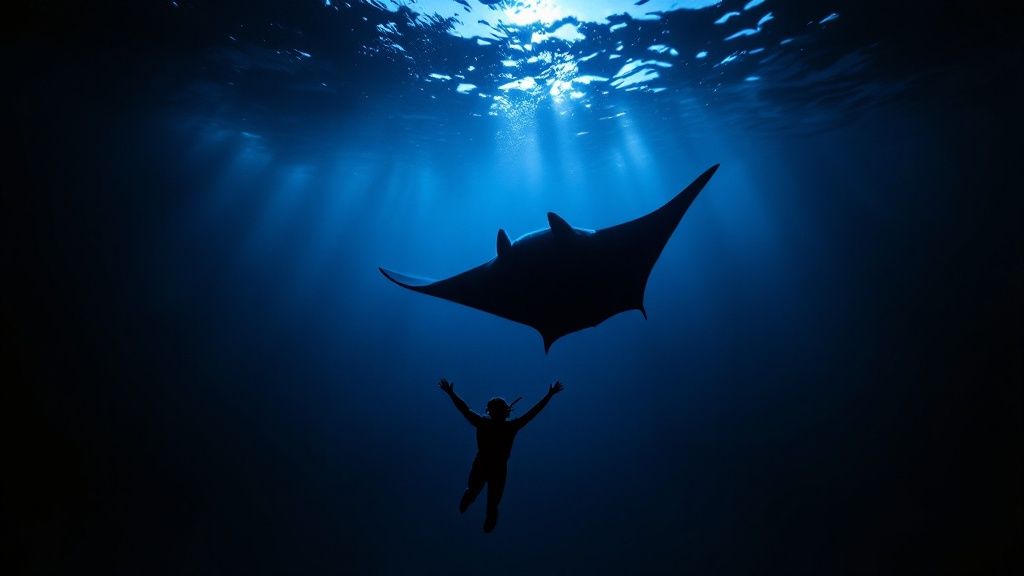
First up, what to wear. Your best bet is to show up at the check-in spot already in your swimsuit. It just makes everything quicker and easier. Even though the air in Kona is warm, the Pacific gets surprisingly cool after dark, especially when you're floating for a while. A wetsuit is an absolute must, and don't worry—your tour operator will provide one for you.
For after the snorkel, think cozy. Pack a fluffy, dry towel and a warm sweatshirt or change of clothes for the boat ride back to the harbor. Trust me, there’s nothing better than sipping some hot cocoa all bundled up after an incredible swim.
Getting Comfortable With Your Gear
If you’re a first-timer, the snorkeling gear can look a bit complicated. It’s really not, and your guides are total pros who will help you get everything sorted. Any good tour will provide high-quality, sanitized masks, snorkels, and wetsuits.
The most important piece of the puzzle is a good mask fit. Your guide will show you a simple trick: hold the mask to your face (without the strap) and breathe in a little through your nose. If it sticks, you’ve got a good seal! The wetsuit should feel pretty snug—that’s how it works its magic, trapping a thin layer of water against your skin to keep you warm.
Pro Tip: If you have a mustache, a little dab of vaseline on your upper lip can work wonders to help the mask seal properly and keep water from leaking in.
Easing Any Pre-Trip Nerves
It’s totally normal to feel a bit nervous, especially if you aren’t a super confident swimmer or are new to being in the ocean after dark. But here’s the great thing: the manta ray night snorkel in Kona is designed to be accessible for just about everyone.
- You don’t have to be a strong swimmer. You'll be holding onto a large, custom-built light board that floats right on the surface. It’s your stable home base in the water.
- The wetsuit makes you float. Seriously, it adds a ton of buoyancy, so you can just relax on the surface without any effort.
- Guides are right there with you. Your safety is always the number one priority. Expert guides are in the water with the group the entire time, making sure everyone is safe and having a blast.
This whole experience is built with beginners and even non-swimmers in mind, which is a big reason it has become so popular. From check-in to your return, most tours last between 1.5 to 2 hours, including the boat ride and safety briefing. The light boards do the work of attracting plankton, which in turn brings the majestic mantas right up to you. You can see what other local experts on the subject have to say about how it all works.
Once you focus on getting comfortable, you can let any anxiety melt away and just be present for the incredible show happening right below you. Brushing up on a few general snorkeling safety tips before you go is also a great way to build confidence.
Ready for an adventure of a lifetime? Securing your spot is the next step.
What To Expect During The Snorkel
The excitement really starts to kick in the second you step on the boat. As the Kona coastline melts into twilight, the trip out to the manta site is short but absolutely beautiful, setting the perfect mood for what’s about to happen. This isn’t just some tour; it's a carefully planned encounter with one of the ocean's most incredible animals.
Once the boat anchors, your guide will walk you through a quick but crucial safety briefing. They'll cover the gear and the biggest rule of the night: observe only, do not touch. The whole point is to make you feel completely comfortable before you even hit the water, keeping both you and the mantas safe. Then, it's time for the best part—slipping into the dark, calm ocean.
Entering the Underwater Theater
Getting into the ocean at night for the first time is a feeling you won't forget—it’s a wild mix of thrill and total peace. The water feels great thanks to your wetsuit, and there's a quiet energy all around you. You’ll swim a very short distance over to a custom-made light raft. This is basically a floating viewing platform.
Everyone holds onto this raft as it shines powerful, eco-friendly lights straight down into the water. This light creates what a lot of us call an underwater "campfire." The bright beams attract huge clouds of plankton, which is exactly what the manta rays are here to eat. You just float at the surface, holding on, and wait for the show to start. No serious swimming is required, which makes it an amazing experience for almost everyone.
The moment that first manta appears is pure magic. One second you're just looking into the glowing water, the next, a massive, graceful shadow emerges from the deep, gliding right into the light.
The Graceful Ballet Begins
When the mantas show up, they start their incredible feeding ballet. Mouths wide open, they do these slow, gorgeous barrel rolls and somersaults, swooping through the plankton. It’s common for them to get within inches of your mask, their huge white bellies glowing under the lights. It’s a stunningly close and personal encounter that will leave you speechless.
It's a full sensory experience. You’ll hear the gentle lapping of the ocean and the sound of your own breathing through your snorkel. Visually, it’s all about the stunning contrast between the deep, dark ocean and the brightly lit "stage" where the mantas perform. Trying to capture it on camera can be a challenge, but our guide on how to take amazing underwater pictures has some great pointers.
The number of mantas you see can really depend on the spot. At 'Manta Heaven,' for example, sighting records show an average of 11 manta rays per night. Head over to 'Manta Village,' and the average is closer to 4 per night. These stats just go to show how each location offers a slightly different, unique experience.
Your guides are right there in the water with you the whole time, pointing out specific mantas (yep, many have names!) and sharing cool facts about them. This turns a simple viewing into a genuinely educational moment. After about 30-45 minutes in the water, you'll climb back onto the boat, buzzing from the experience and ready for a warm drink on the ride back to the harbor.
Your Manta Ray Snorkel Questions Answered
Even with all the excitement bubbling up, it's totally normal to have a few questions before you take the plunge. We get it. Think of this as your go-to spot for clearing up those common queries we hear all the time from fellow adventurers. Getting good, straight answers is the best way to feel confident and ready for the incredible night ahead.
Is The Manta Ray Night Snorkel Safe?
Absolutely. Safety is the number one priority for any reputable tour operator out here.
First off, let's talk about the stars of the show: the manta rays themselves. These are incredibly gentle giants. They're filter feeders, which means their diet consists of tiny plankton. They have zero teeth, stingers, or barbs. Their only defense mechanism is to gracefully swim away.
Every tour is built around a solid safety framework. Here’s what you can expect in the water:
- Expert Guides: Professional, certified guides are right there in the water with you, keeping a close eye on the group and the ocean conditions.
- Top-Notch Gear: You'll be kitted out with a well-maintained wetsuit for warmth and buoyancy, plus a quality mask and snorkel.
- A Floating Home Base: Snorkelers hang onto a large, custom-built light board that floats on the surface. It’s your stable handhold for the entire experience, so you always have something secure to hold.
These measures create a really controlled and secure environment, letting you kick back (gently!) and just soak in the magic.
Do I Need To Be A Strong Swimmer?
Not in the slightest. This is probably the biggest misconception about the manta ray night snorkel Kona experience. The whole thing is designed from the ground up to be accessible for everyone, including total beginners and even non-swimmers.
The combination of the buoyant wetsuit and the big, stable light board you hold onto does all the heavy lifting. You just need to be comfortable floating on your stomach in the water with the gear on. There’s really no swimming involved—it's more like floating and watching the show unfold beneath you.
What Is The Best Time Of Year To See Manta Rays in Kona?
This is one of the best parts about planning an adventure in Kona: there's no bad time to go. The reef manta rays here are a resident population, meaning they live here year-round and don't migrate away.
They show up for their nightly plankton buffet with amazing consistency, no matter what month it is. Sighting success rates stay incredibly high—often over 90%—all year long. So, whether you’re visiting in the sunny summer months or during the winter whale season, your odds of a mind-blowing encounter are just as good. It’s a reliable highlight for any Big Island trip.
What Happens If We Don't See Any Manta Rays?
While sightings are incredibly reliable, we're still dealing with wild animals, and nature is never 100% guaranteed. On very rare occasions, the mantas might decide to skip dinner at their usual spot.
Good tour operators know this is a possibility and almost always have a "manta guarantee." If your tour doesn't see any mantas, most companies will invite you to come back another night, free of charge, on a standby basis. It's always smart to confirm this policy before you book.
Pro Tip: Try to schedule your manta snorkel early in your vacation. That way, if you happen to hit one of those super rare, unlucky nights, you have plenty of time to reschedule and try again.
Booking your tour is the final step. Choosing a company that prioritizes safety, education, and sustainability is the key to having the best and most respectful experience possible.
At Kona Snorkel Trips, we're all about providing a safe, respectful, and completely magical encounter with Kona's gentle giants. Learn more about our premier Manta Ray Snorkel Kona tour and get ready for an adventure you'll never forget.
